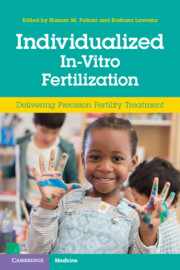Book contents
- Individualized In-Vitro Fertilization
- Individualized In-Vitro Fertilization
- Copyright page
- Contents
- Contributors
- Chapter 1 Individualized Ovarian Stimulation for Normal and High Responders
- Chapter 2 Individualized Ovarian Stimulation in Patients with Advanced Maternal Age and Premature Ovarian Aging
- Chapter 3 Individualized Oocyte Maturation
- Chapter 4 Individualized Luteal Phase Support
- Chapter 5 Individualized Management of Male Infertility
- Chapter 6 Individualized Fertilization Technique in the IVF Laboratory
- Chapter 7 Individualized Genetic Testing
- Chapter 8 Individualized Embryo Selection
- Chapter 9 Preparation for Optimal Endometrial Receptivity in Cryo Cycles
- Chapter 10 Individualized Immunological Testing in Recurrent Implantation Failure
- Chapter 11 Individualized Embryo Transfer
- Index
- Plate Section (PDF Only)
- References
Chapter 11 - Individualized Embryo Transfer
Published online by Cambridge University Press: 12 February 2021
- Individualized In-Vitro Fertilization
- Individualized In-Vitro Fertilization
- Copyright page
- Contents
- Contributors
- Chapter 1 Individualized Ovarian Stimulation for Normal and High Responders
- Chapter 2 Individualized Ovarian Stimulation in Patients with Advanced Maternal Age and Premature Ovarian Aging
- Chapter 3 Individualized Oocyte Maturation
- Chapter 4 Individualized Luteal Phase Support
- Chapter 5 Individualized Management of Male Infertility
- Chapter 6 Individualized Fertilization Technique in the IVF Laboratory
- Chapter 7 Individualized Genetic Testing
- Chapter 8 Individualized Embryo Selection
- Chapter 9 Preparation for Optimal Endometrial Receptivity in Cryo Cycles
- Chapter 10 Individualized Immunological Testing in Recurrent Implantation Failure
- Chapter 11 Individualized Embryo Transfer
- Index
- Plate Section (PDF Only)
- References
Summary
Despite the various advances and the increasing success rates of assisted conception treatment, implantation continues to be a rate limiting step. For implantation to occur a blastocyst must attach to and invade the endometrium and as such both the embryo and endometrium are considered critical to the process of implantation. However, there are other factors to consider. Many conditions of the uterine cavity may influence the ability of the embryo to implant such as uterine submucosal fibroids and endometrial polyps, which are well recognized to exert an adverse effect. In addition, an embryo’s implantation potential may be affected by sperm and oocyte quality. Iatrogenic factors such as laboratory conditions and embryo transfer technique play an important role in successful implantation, hence this chapter will focus on the embryo transfer procedure. This is the final step in the treatment cycle, the culmination of both clinicians’ and embryologists’ efforts and a day of great hope for the patients. The importance of the embryo transfer procedure is not to be underestimated. This chapter will highlight the importance to clinicians of not adopting a “one-size-fits-all” approach when planning embryo transfer. It is incumbent on reproductive medicine specialists to focus on the embryo transfer procedure, try to preempt any potential issues that may adversely affect success rates and adopt an individualized plan for embryo transfer when necessary.
- Type
- Chapter
- Information
- Individualized In-Vitro FertilizationDelivering Precision Fertility Treatment, pp. 130 - 136Publisher: Cambridge University PressPrint publication year: 2021



